The issue of low skills and joblessness has snowballed into gargantuan proportions. With a new government at the helm, what can we look forward to in the next five years for apprenticeships and vocational skills development?
The Facts
- 58.3% of unemployed graduates and 62.4% of unemployed post-graduates have cited non-availability of jobs aligning with their education and skills as the primary reason for being unemployed.[i] This clearly indicates that a higher degree does not necessarily equate to higher employability.
- A dismal 4.69% of India’s workforce has formal vocational skills, as against 60%- 90% in developed countries.[ii] The unskilled and semi-skilled categories in the estimated 12 million youth joining the workforce each year make up the lion’s share.[iii]
- An incremental human resource requirement of 103.4 million and skills training for 126.87 million between 2017-2022 was estimated by the Ministry of Skill Development and Entrepreneurship (MSDE).[iv]


What About Apprenticeships?
Recognising the pivotal role of apprenticeships as an industry-led, application-oriented, effective mode of formal training, the current government launched the National Apprenticeship Promotion Scheme (NAPS) in 2016 with an outlay of ₹10,000 crores-the highest pecuniary scheme for skill building in India in seven years. Why was it done? Extensive international research has found almost panacea-like qualities in apprenticeships.
ILO Director-General Guy Ryder, has described ‘quality apprenticeships’ as the “gold standard”, and said, “Countries where apprenticeship systems are strong, youth unemployment rates mirror those for adults. Where apprenticeship systems are weak, youth unemployment is typically much higher, reaching three or even four times the adult unemployment rate.”
What Can Be Better?
Notwithstanding several industry-oriented amendments to the Apprentice Act (1961), a lot can be improved.
- Funds underutilisation- Of the Rs. 10,000 crores allocated to NAPS on its launch, a mere Rs. 108 crores have seen the light of day.[v] With grave implications. Against a target of 50 lakh apprentices to be trained by 2019-20, at best there are 3-4 lakh apprentices in the country today.
- Evidence-Based- Skill development policy decisions in India suffers from a serious dearth of robust data and research.Which experts believe is a key reason why we are failing to gain ground at the required pace. One critique is that the MSDE does not have a dedicatedR&D fund for skill development. Another, there does not exist a comprehensive Labour Management Information System- a shared platform providing credible data to key stakeholders- which majorly impedes the very purpose of skilling resulting in extremely poor linkages between skill acquisition and industry demand.[vi]
Pronab Sen, former chief statistician of India elucidates this further, “Skill India caters to the supply side. On the demand side, information systems aren’t agile enough to point us to where the jobs are. What could’ve been a skill shortage area five years ago might be facing a surplus today.”
You may also like: Why Do We Need Skill Development Indicators? and Deconstructing the Apprenticeship Stipend Primer 2019 – Part I
- Consolidation: All ‘learn and earn’ schemes such as apprenticeships need to come under the purview of the Apprentice Act. This will automatically boost apprenticeship numbers manifold by allowing employers to utilise the various offerings under the Act, and at the same time provide youth with a standardised work-based experience in accordance with the stipulations of the Act.
- Further Reforms in the Act- Sandip Somany, President FICCI explains [vii]– With 76 million small scale firms in India with an average head-count of less than 6 people, if the Apprentice Act allowed hiring of even one apprentice, and even half of the firms onboard one each, close to 40 million new apprenticeships are instantly created.
- A Separate Entity – Jobs creation is currently a floating problem. What it needs is a dedicated body akin to a UIDAI-like body focused on labour-intensive sectors, opines Vikram Kirloskar, President CII [viii]. In a heartening very recent development, a Cabinet Committee on Employment and Skill Development has been formed by the new government to galvanise jobs growth, headed by the Prime Minister himself [ix]. Besides government representation, it will be interesting to see if other key stakeholders such as from industry are drawn in. Additionally, apprenticeships deserve a befitting prominent mandate in this new entity.
New Beginnings
The blueprint is in place, along with the right intentions- looking back at the last five years provides valuable insight into how the next five can and should lay the ground for apprenticeships and vocational training in the country.
References
[i] 5th Annual Employment-Unemployment report 2015-16- Labour Bureau- Ministry of Labour and Employment
[ii] Annual Skill Report 2016-17- Ministry of Skill Development and Entrepreneurship
[iii] Knowledge paper on skill development in India: Learner first- EY
[iv] Annual Report 2016-17- Ministry of Skill Development and Entrepreneurship- Skill India
[v] RTI query from the Directorate General of Training, Ministry of Skill Development and Entrepreneurship on 13 June 2018
[vi] Skill Development in India: Need, Challenges and Ways Forward, Vandana Saini, April 2015
[vii] Govt should amend Apprentice Act to create more jobs: Ficci’s Sandip Somany- Jan 7 2019, LiveMint
[viii] India Inc suggests separate body to focus on job creation- May 28 2019, New Indian Express
[ix] PM Modi forms two Cabinet panels to spur investment and employment- Jun 5, 2019, Times of India














